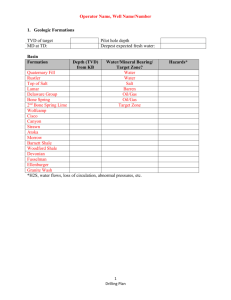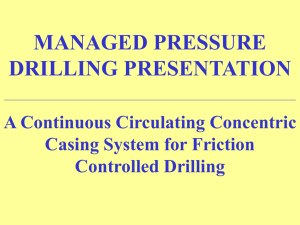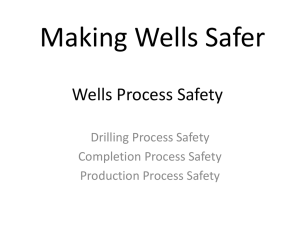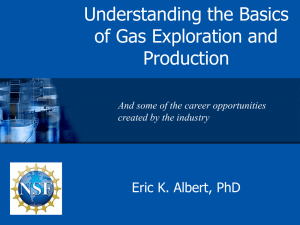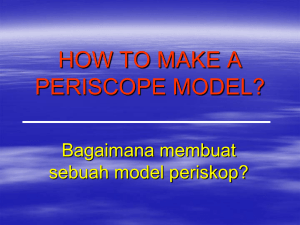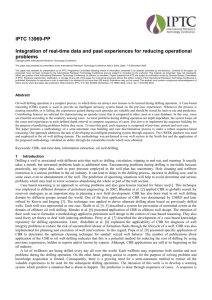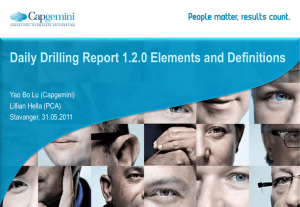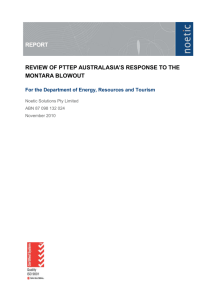Presentation Slides
advertisement
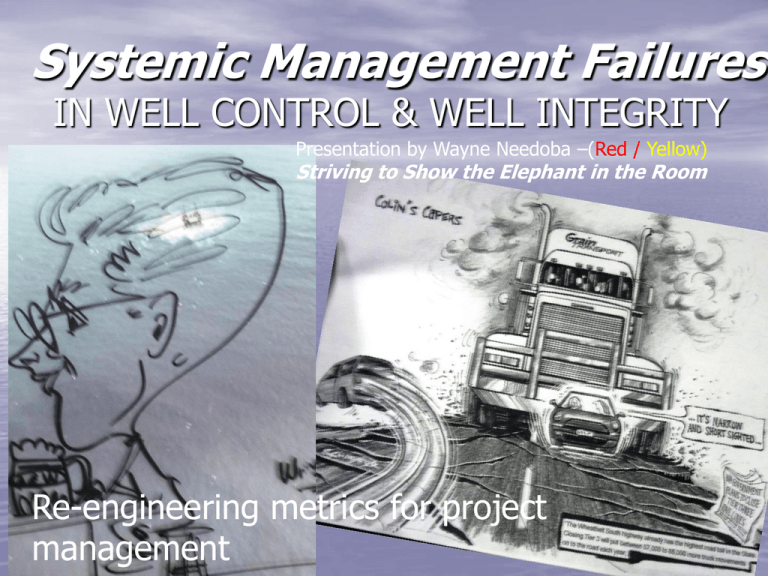
Systemic Management Failures IN WELL CONTROL & WELL INTEGRITY Presentation by Wayne Needoba –(Red / Yellow) Striving to Show the Elephant in the Room Re-engineering metrics for project management Systemic Management Failures- Solutions Learning Thru’ Stories of Metrics & Multimedia Montara Blowout Timor Sea August /09 Key Biscayne Sinking Esso Australia Offshore WA – Perth Early /83?? Marlin Blowout Bass Strait Esso Australia Nov / 68 Systemic Management Failures PTTEPAA Montara • in its original Action Plan, PTTEP AA had not identified the actions needed to address the systemic organisational and governance issues that provided the environment for the Montara Blowout to occur • PTTEP AA has a plan that effectively responds to the issues raised in the MCI and importantly the plan sets the company on the path to achieving industry standards for both good oilfield practice and good governance. “Success of PTTEP AA’s program for change will depend entirely on the quality of execution” Systemic Management Failures PTTEPAA Montara Story – Sim Ops Industry culture is to focus on managing commercial risk, like mitigating the well development of costs, and competition (tendering) there is little transparency of the facts, so few lessons learned by the regulatory, the operator and the public. Prior to the Montara Incident there were 8 kicks while drilling Montara wells There is still a story to be told. Well control and well integrity reliability reliability have a geological hazard as a perceived risk. Systemic Management Failures BP Macondo • the National Commission clearly define "systemic • • management failures" as being a dysfunction because of an inability to communicate changes to drilling procedures in the weeks and days before implementation were typically not subject to any peer-review or MOC process. decisions appear to have been made by the BP Macondo team in ad hoc fashion without any formal risk analysis or internal expert review. This appears to have been a key causal factor of the blowout. The Well System - Montara It started with a burp Finding 2 The installation of the cemented shoe was defective in that, after failure of floats/ valves located in the shoe apparatus, displacement fluid was pumped beneath the float collar which resulted in over‐displacement of cement from the casing shoe track and in the area outside the casing shoe (called the annulus). Finding 3 The pumping back of this displacement fluid was contrary to sensible oilfield practice, and led to a so‐called ‘wet shoe’. Casing shoe 90 degrees High Porosity Gas Leak through Floats The result was that the cemented shoe lacked integrity as a barrier. *Note that the gas burp occurred months after the casing had been cemented. The Well System - Formation Dip High & High Porosity Macondo The burp was a surge. Common Factors – Production Casing Design Float Equipment Failure Unrecognized Well Conditions • Montara Finding 44 Had key personnel from both • • • PTTEPAA and Atlas (on‐rig and onshore) possessed a greater level of knowledge and expertise in relation to cementing operations, it is likely they would have detected (i) the problem with the cemented casing shoe, thereby enabling remedial steps to be taken; Macondo - Integrity test failed to identify communication with the reservoir - Operations allowed the influx to enter and move up the well bore - well became capable of flowing - Rig crew response to well flow failed to control the well Management Systems Drilling and Completion Operations Defining Systemic Management Failures Relative to managing “Process Risk” with Certainty Seeing the Elephant in the Room • What prevents D&C organizations reaching desired reliability. Focus on commercial risk? Current Collaboration Processes Seeing impact of the EITR BP Macondo Supervisors Criminally Negligent? David Pritchard Current Collaboration Processes Eg. JHA HAZARD TYPE FACILITIES AND PERSON AT RISK Well Control - Low Risk. Oil in tubing Platform personnel Note Emergency Response Plan Standpipe pressures in excess of 3000 psi Pump, standpipe and rig floor areas Tripping - high T&D, no top drive. Rig floor personnel Develop Methods to Eliminate or Control Perceived Risks 1. Find a Better Way to Do the Job 2. Review Job Procedure to Determine Possible improvements 3. Study Environmental Changes if Procedural Changes Insufficient 4. Consider Ways to Reduce Frequency of Performing the Job 5. Familiarize yourself with the associated hazards of the job. Why is there not learning so loss control and death can be history on well operations? Possibility to Eliminate Systemic Management Failures in Complexity USE WELL CONTROL AND WELL INTEGRITY FAILURES to: 1.1 Strengthen Human Resources Quality thru’ empowerment using re-engineered metrics for project management. 1.2 Review and Improve the Operator Business Process 1.3 Improve reliability & quality of back end Operations management using using new IT / Satellite / Internet Technologies 1.4 Develop Operator Strategies and Values that Empower thru’ Community Development and Sustainability Programs 1.5 Create a zero tolerance attitude to work process standards: industrial occupational health and operations safety, environmental, system quality (reliability / Sustainability ) The Earth Model Well Evaluation – BOD (Drilling and Completion Basis of Design) The Earth Model and Well System - BOD cont’d POWER OF DIGITAL FILTERING AND INTERACTIVE MULTIMEDIA - Reading the Hole while drilling – Geological Character • If wellbore pressure exceeds the fracture pressure, lost • • circulation may occur. Any reduction in wellbore pressure below pore pressure may cause an influx of formation fluids into the wellbore from permeable zones. At wellbore pressures well above the pore pressure, wellbore stability may also become a problem. Correctly predicting how pore pressure and fracture gradient vary throughout the intervals to be drilled is critical to designing an effective casing program. Pore pressure/fracture gradient profiles are defined from offset wells and modern prediction methods. POWER OF DIGITAL FILTERING AND INTERACTIVE MULTIMEDIA Reading the Hole cont’d POWER OF DIGITAL FILTERING AND INTERACTIVE MULTIMEDIA Reading the Hole Well Profile Well Character POWER OF DIGITAL FILTERING AND INTERACTIVE MULTIMEDIA Reading the Hole • Observations Drilling (CondDR26) required 8 days & cost US$310,000. Running and cementing 20” Casing (CondR&C20) required 5 days & cost US$313,000. An 8 ½” pilot hole was drilled to 1800 ft The formations were dispersing when drilled and making mud. A shallow hot water sand (350 to 500 ft) had flowline temperatures of 135 deg F led to an over run on mud and cement costs (Total cost of consumables for drilling fluids was US$63,000 and for cement was US$54,000). Mud engineering responded to thinning the high viscosity mud (MBT’s exceeding 15) by running 3-4% KCl and PHPA and diluting with desander and desilter on mud cleaner. The cement programme went from running a CaCl2 accelerator to running retarder. POWER OF DIGITAL FILTERING AND INTERACTIVE MULTIMEDIA Reading the Hole Cont’d • Connections were slow • Drilling & tripping times were slow for • • • three reasons: 1. Tesco top drive was new to the rig.. On connections with stands, the traveling blocks had to be positioned very close to the crown. Also, drill tools had to be picked up out of the mouse hole on a double or single. Long and short bales had to be switched around. 2. The weight on bit was maintained around 10 kips to counteract any deviation tendencies and to limit ROP’s for shallow gas well control. 3. Connections were reamed twice to avoid bit balling. POWER OF DIGITAL FILTERING AND INTERACTIVE MULTIMEDIA Reading the Hole cont’d Note Torque (yellow), WOB (blue on right graph) and Gas Units (purple right graph) erratic above 5200 ft Wellbore Quality Quality POWER OF DIGITAL FILTERING AND Wellbore Friction Friction factors factors INTERACTIVE MULTIMEDIA Reading the Hole cont’d Quality POWER OF DIGITAL FILTERING AND Wellbore Friction factors INTERACTIVE MULTIMEDIA Reading the hole cont’d Wellbore Quality Friction factors POWER OF DIGITAL FILTERING AND INTERACTIVE MULTIMEDIA Reading the Hole cont’d Well Bore Quality & Barrier Quality OPERATING MODEL PROPOSED ON THE JOB LEARNING, ON-LINE Reducing the Learning Curve On-line • Enhancing Human Resources & Business Process • Research Interactivity & Awareness Development Improving Performance - Planned Vs. Actual • Process of Continuous Improvement • Planned and Managed Innovation and Change • Reduced Operating Costs and Greater Profitability Thru’ Optimizing Asset Value & Operational Efficiency. Facilitating & Managing Learning - a Web Site • Knowledge management, Lessons Learned, Competency Development • Motivation and Empowerment including coaching and mentoring • Greater harmony in the company and community • Minimum waste, greater creativity, increased productivity • Commercially Self-sustaining through cost savings (benchmarking and planned Vs actual) promotion & e-commerce The Act of Continuous Improvement The cycle of Continuous Improvement Strategic Thinking Process Past Diagnostics (Gap Analysis) Align II Assemble I Data (Collect and Collate ) Future Direction (Strategy for Learning) III Apply IV Assign Do (Facilitating) The Results of Continuous Improvement The cycle of Continuous Improvement Strategic Thinking Process Measuring Competency for Sustainable Profitability IV III II IV I III III IV II I I II Learning Time / Sustainable Actions Learning-Life – Managing Performance Change 0 Performance Improvement Acquired Wisdom Awareness Issues & Actions •Health •Environment •Safety •Quality Level 5 Level 4 Competence Awareness level relative to ISO Responsibility standards Intelligence & Aptitude 40% Learning Strategies Measuring Competency for Sustainable Profitability 100 Performance Acquired Knowledge Skills Concepts Level 3 Level 2 Level 1 Ideology – appropriate paradigms (The Growth Spectrum to Optimised Performance) Creative •Economic & Societal Change Explorative •Regionalism and Cooperation •Cultural Change Ethical •Auditing for Sustainability •Product Stewardship Proactive •Diplomat & technical systems •Integrated Management Systems •HESQ Auditing Reactive •Impulsive & Opportunistic •Technological Fix •Add-on control systems Learning Time & Sustainable Actions) Job Analysis incorporates: TIME, SEQUENCE, RISKS AND HAZARDS, EQUIPMENT & CONTRACTS, PLANNED SEQUENCES •Domain Expert has experience •Visualizes the project jobs planned and analyses them. •Team Builds - develops communication lines between: •departments / employees •technology specialists for planning and research, •consultants and • third party contractors •Verifies the key indicators for monitoring •Liaises with Management & HRD to set Research and Training Strategies •Participates in operational surveillance Disciplines of a Learning Organisation (Quoted from The Fifth Discipline – The art and practice of The Learning Organizaion – Peter Senge) • Systems Thinking (in conjunction with satellite and web communication, interactive multimedia, and collaborating data bases) • Personal Mastery (competence including awareness of responsibilities on issues of Health, Environment, Safety and quality (HESQ)). • Mental Models (thinking, actualising, creating, innovating based on awareness of HESQ issues and intrinsically motivating feedback). • Building Shared Values (managing cultural and behavioural change) • Team Learning (developing group IQ through strong EQ (emotional literacy)). Planned Vs Actual - Work Scope Sequence Monitoring - Benchmarking Purpose: Continuous Improvement - Working more Cleverly to reduce operating costs & enhance asset value Benefit: Reduces Learning Curve, Maximizes Operational Efficiency & Asset Value for maximum, sustainable profit to company and community. Methodology •Comparing Planned Vs Actual and sharing lessons learned •Recognizing Root Cause of Failure •Researching and Creating new ideas •Passing on Experience •Using Innovative Technology Planned Vs Actual-Performance Metrics Key Indicators - Cost, Time, HESQ Purpose: Measurables of Performance - Rewards / Compensation Benefit: Motivation to be clever Methodology - Reward System •Management (Cost Savings - less time, less consumption) •Staff (Job Satisfaction, Ownership, Compensation) •Consultants (Job Satisfaction, Ownership, Compensation) •Contractors (Incentives, Ownership, Compensation) The Matrix Organisation Achieveing Sustainable Energy Practises Overview of Integrated Functions & Systems Collaboration Knowledge Management / Education / Feedback Creating Learning Organisation (EON) Operations (Scorecard / KPI / Benchmarking) Competence Social Responsibility Assessment & Skills (SHAWPAT) Feedback–Lessons Learned Certification (TISI-SPE) Continuous Improvement UNITY ALLIANCES PROJECT COORDINATING Sunflower-life Styles SYSTEMS THINKING BEST PRACTISES MOTIVATION & COMPETENCY RELATIONAL EQUITY MANAGEMENT DUE DILIGENCE & FEASIBILITY Due Diligence Feasibility-Case Studies Design & Construction Plant operations and Maintenance Planning & Management Global Trading Commercial Research & Development Administration and Marketing Finances and Accounting Communications & Management Investment & Return on New Projects & Systems Discovery & Innovation Trends & Patterns Gap Analysis &Problem Solving New Technologies Way Forward Creation of Bureau Service – SPE & Universities. Pilot Project Agenda: 1. Demonstrate the Challenges using the existing well planning, well surveillance / well control and materials / contract monitoring system. 2. Allow for a comparison between the existing and an on-line analytical data base and feedback system (pro vs cons) 3. Create the alignment between the proposed tools Internet and IT systems (with, Mindmapping etc) 4. Conclude with a plan for Corporate Operators to achieve competence in reaching the stated Corporate Objectives and Values Facilitate the Learning by: Creating Alertness to Hazards so perceived risks can be managed. 1.Strategic Review for Achieving Competence The goals of “needs analysis” is to go across the organizations to evaluate communication and collaboration processes, jobs and people. Its expressed a little bit in the words below in relation to having well control while drilling. “To be competent in well control, a supervisor is responsible for discerning what is relevant information, then disseminating it to relevant key personnel. The quality of information transfer is measured by how close it is to what is really happening. A loss of orientation, e.g. due to decisions that follow incomplete or inaccurate data, and its poor interpretation (if it isn't actually happening), is a major reason for loss of control to occur” Ensuring there are competence in people and effective systems to collect, collate and disburse the data from drilling outcomes down hole to others in the system, leads to optimum performance and lessons learned. Note Conclusions “Disastrous Decision” Dr. Andrew Hopkins Facilitate the Learning by: cont’d 2. Establishing a web portal for facilitation & execution of a well determining root • • • • cause and using open collaboration Interlink databases and Operator / Contractor systems. Demonstrate how program feedback on line can enhance performance through reduced learning curves Use multi functional and interdepartmental collaboration to enhance system creativity. Create a motivational and empowerment feedback system in relation to the issues of Health, Environment, Safety & Quality “best practices”. Facilitate the Learning by: cont’d 3. Create Interactive Alliances with the Suppliers and Contractors through a Materials Management system and Chart of Accounts Using a material and time indexed data base, track all usage and cost of contractor activities and material & equipment usage by: – Contractor name and equipment name – Contract number and purchase order – Requisition and Receipt – Use and Consumption by well activity, phase and hole size – Consignment, Lost In Hole, Waste / NPT, Failure – Environmental impact Facilitate the Learning by: cont’d 4. Demonstrate using Domain Experts, Mentors & Champions through pilot projects, assessment and induction Programs by: - Induction to the rig site – – – Best Practises Training incorporating “Stop for Safety” “TRUE” and HSE meetings used by operator and contractors Demonstrating a computer based personal assessment and continuous improvement process incorporating all project functions and personnel. Encapsulate HESQ in Technical and Logistical initiatives for all company, contractor and community participants. Obtain Approval from & involve Regulator & Standards Organizations Pilot Projects Incorporating Social Responsibility • Operator and Regulator target revitalization of Brownfields to significantly enhance resource objectives. Incorporate initiatives leading to a “Brownfield Focus” in Oil and Gas Development. Changing Focus Macro Focus Operational Focus Production Profile Involving Migas, BP Migas, PSC’s and Academia. Brownfield Micro Focus Conclusion: Opportunity Cost for Achieving Competence thru’ a Pilot Project • A one well project with a budget in excess of 7 million dollars • • • so savings from optimizing performance in range of 1 million dollars – Sufficiently significant to create a Realization Attitude & Practises of the drilling contractor are synergistic with the Goals and Policies of Star Energy “Drilling Supervisor” could play the role of “Domain Expert” while ensuring operational responsibilities are met. All Functional Specialists mentioned share cost for creating the learning system, Miscellaneous Expenses for Corporate would include: 1. Strategic Revisions 2. Establish Web Portal and Integrating with secure IT systems (Cloud 3. 4. Computer Technology. Create Interactive Alliances with Materials / Third Party Management System Demonstrating Use of Domain Expert, Mentors, Champions and Induction / Assessment for Continuous improvement THOUGHTS - CORPORATE OBJECTIVES TO ASSURE CERTAINTY IN WELL CONTROL AND WELL INTEGRITY RISK MANAGEMENT 1.1 Strengthen Human Resources Quality through: – Implementation and internalization of corporate culture. Establish plan and method of “affective internalization” . – Develop a “Affective” Manpower Development and Continuous Improvement Learning Process for the organization, contractors, suppliers and adjacent community based on core purposes and competencies. – Rotation of key personnel. Management team to identity the people and establish a plan for appropriate leadership for each situation. – Selective positioning of appropriate “project coordinator” for each new project requirement or to strengthen the organization performance. 1.2 Continue to review and to improve the Corporate Business Process – Assure efficiency and best corporate practices. Operation dept and Support departments to conduct a review of major impact business processes as a “gap analysis” THOUGHTS - CORPORATE OBJECTIVES IMPROVEMENT – cont’d 1.3 Improve quality of employees’ understanding and familiarization with the Company IT and ERP system across the organization to enable them to utilize the system effectively. Conduct familiarization training for everyone with cost monitoring and budgeting process, logistic and procurement and HR system. Coordinator : Sr. Mgr Engineering/ IT Manager 1.4 Develop Company’s strategy and Policy on Community Development and Relation Programs that will support the Company long term strategy and objectives. Coordinator : VP Admin/ Ext Rel Mgr 1.5 Maintain high standard of industrial safety and environmental practice: Zero Fatalities, Zero Lost Work Cases, Zero Oil Spills and 100% compliance to the globally recognized Environmental Standards. Coordinator : VP Operation



